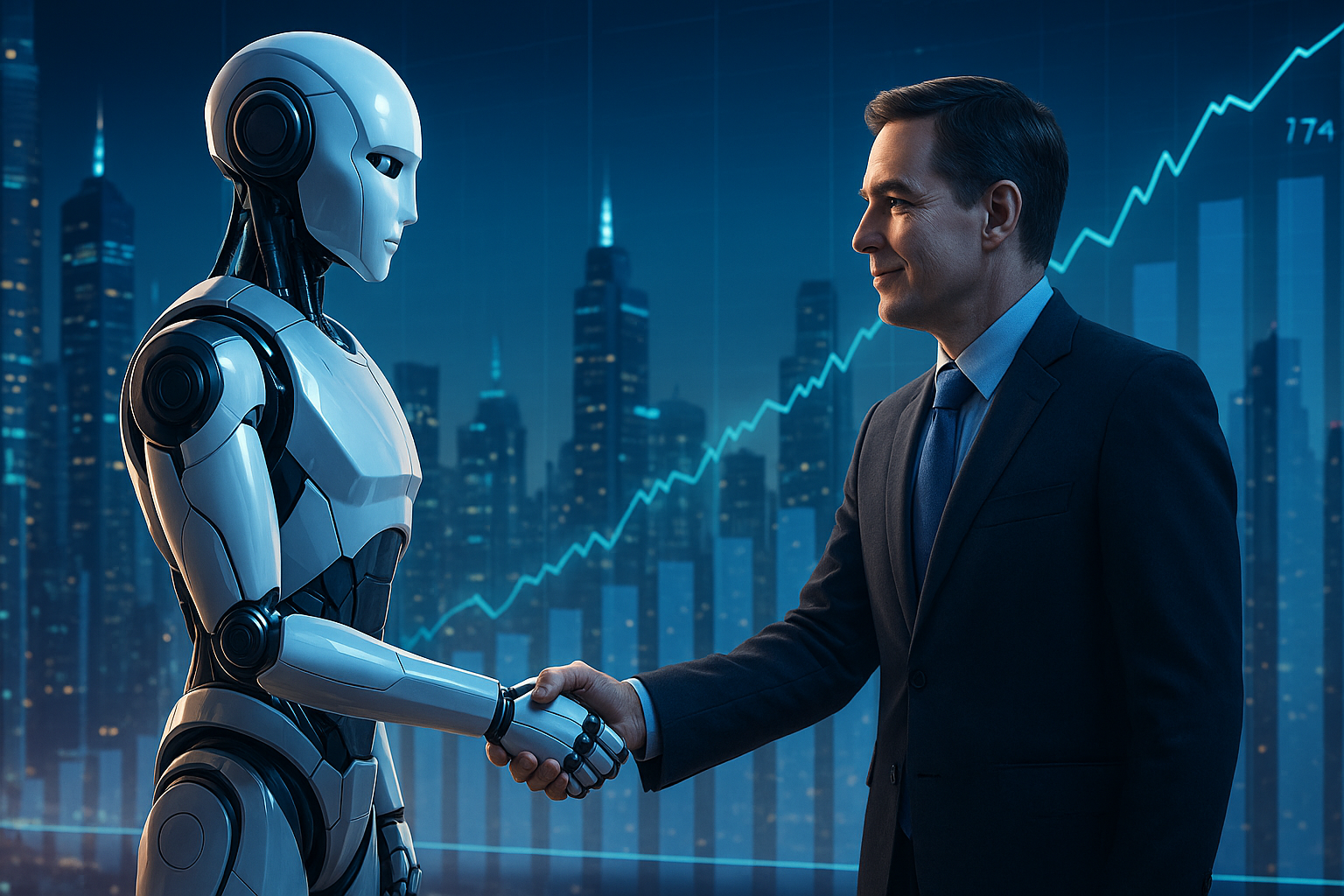Humanoid robot stocks stand ready for a market explosion. Goldman Sachs expects shipments to jump from just 3,500 units in 2025 to 1.4 million units by 2035. The sector should hit $38 billion in market value by 2035. Morgan Stanley goes further. They see the total addressable market hitting $3 trillion.
These stocks have the same explosive potential that Nvidia had in its early days. They offer investors a rare opportunity to get in at the ground level. The Tesla Optimus robot development, combined with the Nvidia robotics platform, is reshaping the future of automation. Elon Musk predicts that humanoid robots could outnumber humans two to one by the 2040s, a bold vision that underscores the massive potential for early investors. This blog dives into why humanoid robot stocks might revolutionize the tech sector, echoing Nvidia’s meteoric rise in AI.
The Market Potential of Humanoid Robot Stocks in 2025
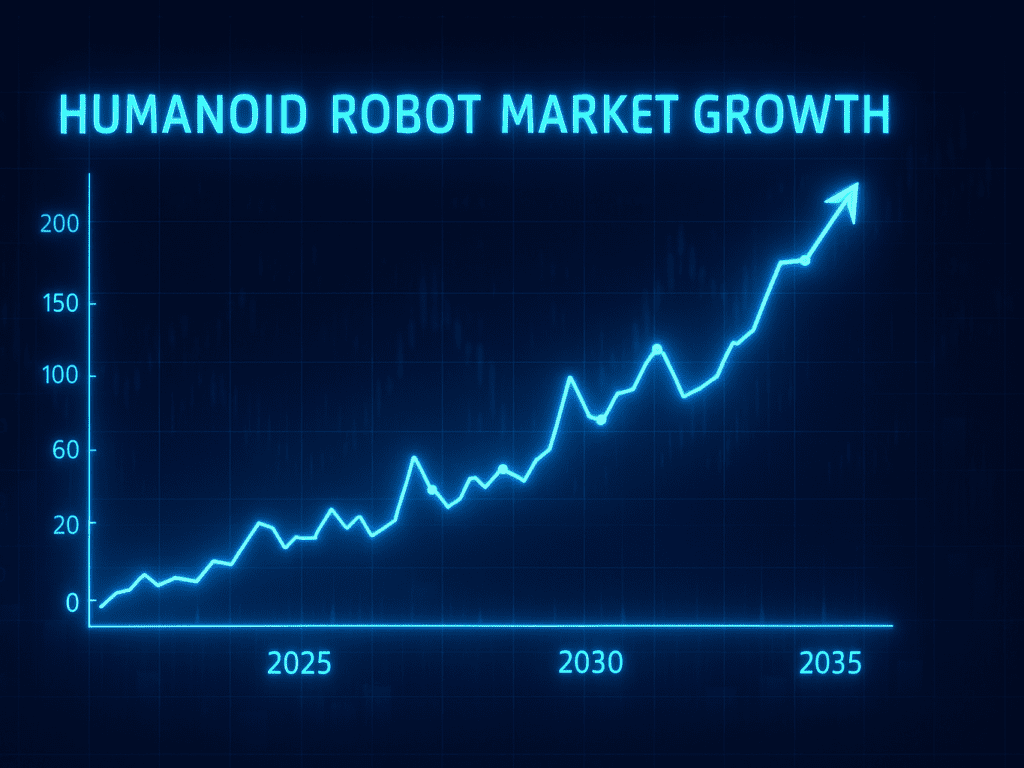
The humanoid robotics sector shows incredible growth potential. It could revolutionize investment opportunities. Market projections estimate the humanoid robot market will be about $2.03 billion in 2025. Early investors in these emerging technologies stand to gain significantly.
1. Growth projections for the humanoid robotics sector
The numbers for humanoid robot stocks paint an impressive picture. Technavio expects the global humanoid robot market to hit $59.18 billion by 2029. This represents a compound annual growth rate (CAGR) of 70.4% during its forecast period. Markets and Markets see the sector growing to $13.25 billion by 2029, with a 45.5% CAGR from 2024.
The long-term outlook for humanoid robots looks even better. Goldman Sachs raised its total addressable market estimate. It went from $6 billion to $38 billion by 2035. They credit this increase to AI advances and more investment in the sector. Citigroup predicts that sales of humanoid robots will reach $209 billion by 2035. By 2050, that number could soar to $7 trillion.
The Business Research Company offers a closer view. They expect these stocks to grow from $3.68 billion in 2025 to $5.60 billion in 2026 at a 52.1% CAGR. The market should expand further to $30.03 billion by 2029. These projections show how quickly this sector changes. Analysts keep raising their estimates.
2. Comparison to early-stage Nvidia investment opportunity
Today’s humanoid stocks look a lot like early-stage Nvidia. Nvidia has become a key technology provider in humanoid robotics. They expect this category to grow into a major AI market by 2028. Jensen Huang, the CEO, says robotics is already a “multibillion-dollar business for us.” He believes it will grow to be “one of the largest businesses for the company long term.”
Nvidia just launched a full range of technologies to boost humanoid robot development. NVIDIA Isaac GR00T N1 is the first open, customizable foundation model for humanoid reasoning and skills. This strategy mirrors how Nvidia dominated the AI chip market early on.
The timing feels similar, too. Early Nvidia investors got in on AI computing early. Now, humanoid robots present a similar chance to invest from the ground up. Morgan Stanley thinks this could grow into a $3 trillion market.
3. Key market drivers fueling industry expansion
Several factors speed up humanoid robot adoption and boost stock potential. The global labor shortage tops the list, with more than 50 million people needed worldwide. China has special demographic challenges. Its humanoid robot market is set to reach RMB 75 billion (about $10.3 billion) by 2029.
Here’s what else drives humanoid robot stocks:
- Tech advancements: Better AI, machine learning, improved sensors, and enhanced mobility boost robots’ skills.
- Cost cuts: Production costs for high-spec humanoid robots fell by around 40% last year.
- Goldman Sachs predicts a big boost in industry adoption. They believe shipments of humanoid robots will hit 1 million by 2031. That’s four years sooner than expected.
- Healthcare applications: Medical service robots may reach $84.80 billion by 2028.
Private investment floods into humanoid robotics. In the first two months of 2025, there were 27 financing deals. These deals totalled $614 million, nearly matching all of 2024’s funding. This capital flow will likely keep growing. Robots are now being used in many areas. These include manufacturing, healthcare, retail, and education.
Categories of Humanoid Robot Stocks to Consider
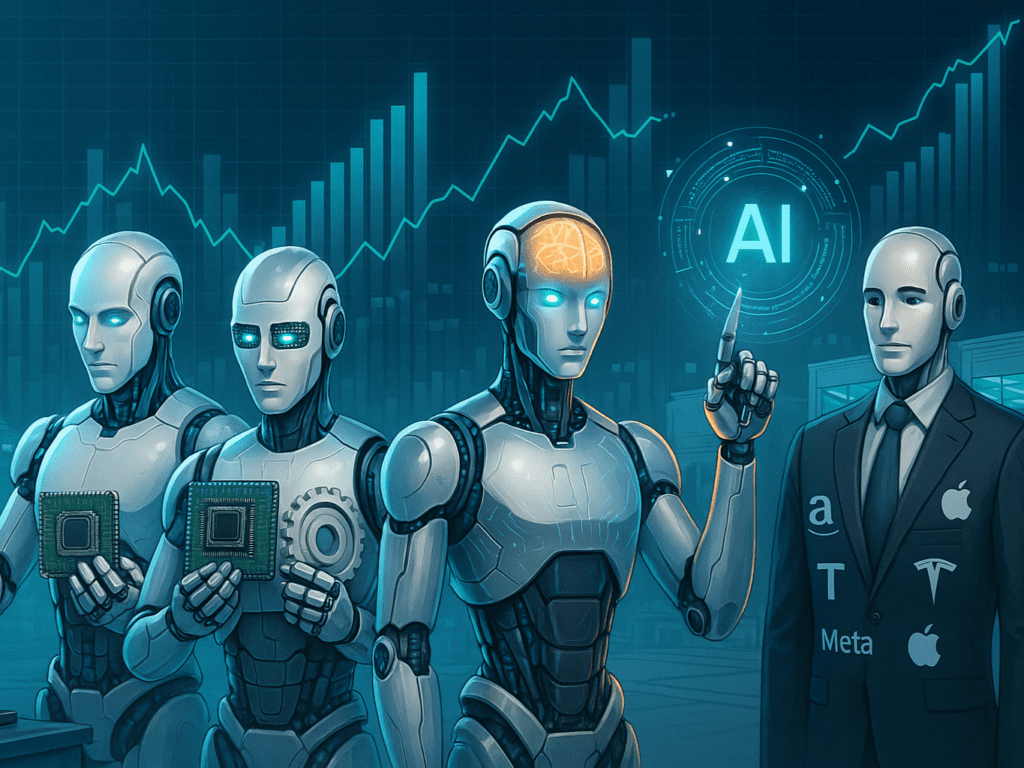
Savvy investors can join the humanoid robotics revolution. They should invest in four types of humanoid robot stocks. Each type provides a unique way to enter the market. They come with different risks and rewards, depending on what investors want and when they invest.
1. Pure-play humanoid robotics manufacturers
The best way to invest in humanoid robots is by choosing companies that build these robots. These manufacturers are making machines that can change how we work in many industries.
Tesla leads the pack with its Tesla Optimus robot project, aiming to produce around 5,000 units in 2025. This bold move has captured the attention of investors, as Tesla becomes the first company to deploy general-purpose humanoids in real business operations. Meanwhile, Boston Dynamics, backed by Hyundai Motor Group, is pushing the boundaries of robotic movement with its agile Atlas robot.
Chinese companies have become strong players in this field. Unitree Robotics has launched its G1 humanoid robot for everyday buyers. The starting price is just $16,000. It is significant because Western competitors charge much more. Agibot (Zhiyuan Robotics) matches Tesla’s goals and plans to build 5,000 robots in 2025.
2. Component and supply chain companies
Component makers are an excellent option for investors looking for profitable humanoid robot stocks. These companies build the vital parts that make humanoid robots work and sell them to multiple manufacturers.
Harmonic Drive Systems stands out. It leads the market for precision reducers. These parts are crucial for humanoid robot joints and actuators. The company controls about 90% of the high-performance reducer market outside China. They expect their robot income to rise from nearly nothing to around $20 million in fiscal year 2025. By 2027, it could hit $69 million.
Key component areas include:
- Lightweight gears and actuators
- Next-generation humanoid hands and systems
- Advanced electric motor technology
- Miniature sensors
- Custom motor and control systems
3. AI and software providers enabling humanoid functionality
The companies making AI “brains” for these machines could have the most growth in the humanoid market. These humanoid robot stocks go beyond just hardware.
Nvidia is now a leading tech provider. They offer a complete package for developing humanoid robots. CEO Jensen Huang says that their Nvidia robotics platform is now “a multibillion-dollar business.”
Morgan Stanley analyst Ed Stanley points out three main investment areas:
- Companies are creating generative AI for the robots’ brains.
- The mechanics that enable their movement.
- Battery storage keeps them powered.
Companies that create natural language processing, computer vision, and other AI features are key players in the humanoid robotics supply chain.
4. Established tech giants entering the humanoid space
Big tech companies are investing more in humanoid robots. They are using their expertise and financial strength.
Amazon is developing a humanoid robot named “Digitron.” It connects with smart home systems. The company plans to use these robots in warehouses first. Then, they might sell them to consumers.
Other tech giants joining the humanoid trend include Tesla and Amazon. Meta, Apple, Alphabet (investing in Apptronik), Microsoft (partnering with Sanctuary AI), and OpenAI may also launch their projects.
Big players add money, AI know-how, partnerships, and market access to humanoid stocks. Humanoid robots are becoming commercially viable. Their involvement could change many industries at once.
Investors who want exposure to humanoid robot stocks but prefer not to pick individual companies can choose robotics-focused ETFs. All the same, knowing these four categories helps build a balanced investment strategy across the humanoid robotics value chain.
Top Publicly Traded Robotics Companies Leading the Humanoid Revolution

Several publicly traded companies have become pioneers in the humanoid robot stocks arena. They stand at the vanguard of what could become a revolutionary market change. These industry leaders are developing technologies. These may decide which humanoid robot stocks will offer Nvidia-like returns for early investors.
1. Nvidia robotics platform and AI infrastructure
Nvidia is now the key tech provider for the next wave of humanoid robot stocks. The company introduced the NVIDIA Isaac GR00T N1. It is the first open, fully customizable model for humanoid reasoning and skills. This platform helps robots understand natural language commands. It lets them learn from demonstrations and manage complex tasks independently. This gives humanoid robots their “brains.”
Jensen Huang, Nvidia’s CEO, says robotics is “a multibillion-dollar business for us already.” The company wants to unlock significant value in the humanoid robot market. Its complete technology stack includes:
- NVIDIA NIM microservices for robot simulation.
- NVIDIA OSMO orchestration service for robotics workloads.
- AI-enabled teleoperation workflow for training.
Nvidia has created a three-computer system for humanoid robot stocks. AI supercomputers train the models. Simulation platforms help robots learn skills. Jetson Thor computers operate directly on the robots. This broad approach has built win-win partnerships with leading humanoid developers. These include Boston Dynamics, Agility Robotics, and Figure AI.
2. Tesla Optimus robot development and timeline
Tesla presents a bold vision in humanoid robot stocks with its Tesla Optimus robot project. Elon Musk even suggested that Optimus could one day surpass the importance of Tesla’s car business. In December 2023, the company unveiled its sleeker Optimus Generation 2, a significant upgrade that can now dance and even prepare food, bringing science fiction closer to reality.
The company’s timeline has changed. Musk first wanted Optimus robots working in Tesla factories by the end of 2025. He updated the timeline: “Next year, Tesla will have helpful humanoid robots. They will be in low production for internal use.” Then, we hope to reach high production for other companies by 2026.” This pushes the timeline back by about a year.
Tesla faces big challenges in making Optimus truly autonomous. Critics say that robots in Tesla’s ads needed remote control for some tasks. Musk’s bold claims about Optimus’s financial impact have raised eyebrows. He suggests it could be valued at “several times” $5 trillion. This has made people wonder about delivery timelines.
3. Traditional industrial robotics firms pivoting to humanoids
Traditional industrial robotics firms are shifting their humanoid robot stock strategies to tap into this new market. Boston Dynamics announced in 2024 that it would stop making hydraulic-powered humanoid robots. They now focus on robots powered by electric motors. Chinese manufacturers lead in this area.
ABB, worth $105 billion in market value, is another key player among humanoid robot stocks. The company’s YuMi collaborative robot works alongside humans in manufacturing. These systems manage assembly, move materials, and ensure quality. They form the basis for humanoid abilities.
Chinese manufacturers hold a strong edge in the humanoid robot supply chain. Morgan Stanley says China controls 63% of key firms that make humanoid robot parts. This mainly includes actuator components and rare earth processing. Lower production costs give Chinese manufacturers an advantage when robots start mass manufacturing.
The market has other notable publicly traded companies developing humanoid technologies. Hyundai Motor Group owns 80% of Boston Dynamics. XPeng has its PX5 humanoid prototype, and UBTech Robotics rounds out the field. Companies offer investors unique paths to join the humanoid robot stock movement. They have different timelines for launching their products.
Under-the-Radar Humanoid Robot Stocks With Explosive Potential
Smart investors look beyond the big names to find humanoid robot stocks with hidden growth potential. Nvidia and Tesla grab headlines, but the best chances to build wealth might come from lesser-known companies in the humanoid robotics world.
1. Component manufacturers with in-monopoly positions
Harmonic Drive Systems stands out as a top under-the-radar stock for humanoid robots. This Japanese company dominates the precision reducer market. These parts are key for making humanoid robot arms and hands move accurately. The company’s market share sits at approximately 90% outside of China. They have become the equivalent of selling picks and shovels in this robotic gold rush.
The company’s market value is ¥286 billion ($1.9 billion). Still, its position in the supply chain is unmatched. High-end humanoid robots need precision parts. This need gives the company significant power as production increases. Chinese suppliers have tried to lower their prices. However, quality issues stop them from competing with Harmonic Drive in premium markets.
Keyence Corporation offers a new investment opportunity with its advanced sensor technology. This tech helps humanoid robots understand their surroundings. This $112 billion company provides the strong infrastructure for next-gen humanoid robot stocks.
2. Emerging startups approaching public markets
Many pure-play humanoid robot companies are private now, but some leaders may go public soon. Figure AI, now valued at $2.6 billion, stands out among new humanoid developers. They raised $675 million to reach this milestone. Their Figure 02 robot launched in August. It uses advanced AI from OpenAI. Also, it has a deal with BMW.
Agility Robotics also secured $150 million from DCVC and Amazon’s Industrial Innovation Fund. Amazon warehouses use their two-legged robot, Digit. It shows real business value.
More humanoid robot stocks worth watching include:
- 1X Technologies (formerly Halodi Robotics) received $23.5 million in Series A-1 funding, thanks to OpenAI’s support.
- Apptronik raised $450 million in March 2025. B Capital led the round, with Google, Mercedes, and ARK Invest also participating.
- Sanctuary AI: Microsoft now works with them to push AI models forward for its humanoid robot.
3. International players gaining global market share
Chinese companies have altered the map of humanoid robot stocks. Morgan Stanley’s “Humanoid 100” list reveals that 56% of confirmed humanoid robotics companies are from China. The market in China should grow from ¥863.4 billion ($119 billion) in 2024 to ¥973.1 billion ($134.1 billion) by 2025.
China’s success stems from strong supply chains, local market support, and government backing. China’s “Made in China 2025” plan promotes automation. The government also funds research and development.
Investors can tap into international humanoid robot stocks through these public companies:
- UBTech Robotics is a $5 billion company. It’s supported by Tencent. They create humanoid robots for education, customer service, and industry.
- XPeng Robotics relies on resources from its electric vehicle parent for the PX5 humanoid prototype.
- Xiaomi: This tech giant now applies its mass production expertise to humanoid robots.
Manufacturing costs for humanoid robots have dropped much faster than expected. Prices fell from $50,000 to $250,000 to $30,000 to $150,000 per unit, a 40% drop instead of the predicted 15-20%. This speeds up factory adoption by about a year and consumer use by two to four years.
How to Build a Diversified Humanoid Robotics Investment Portfolio
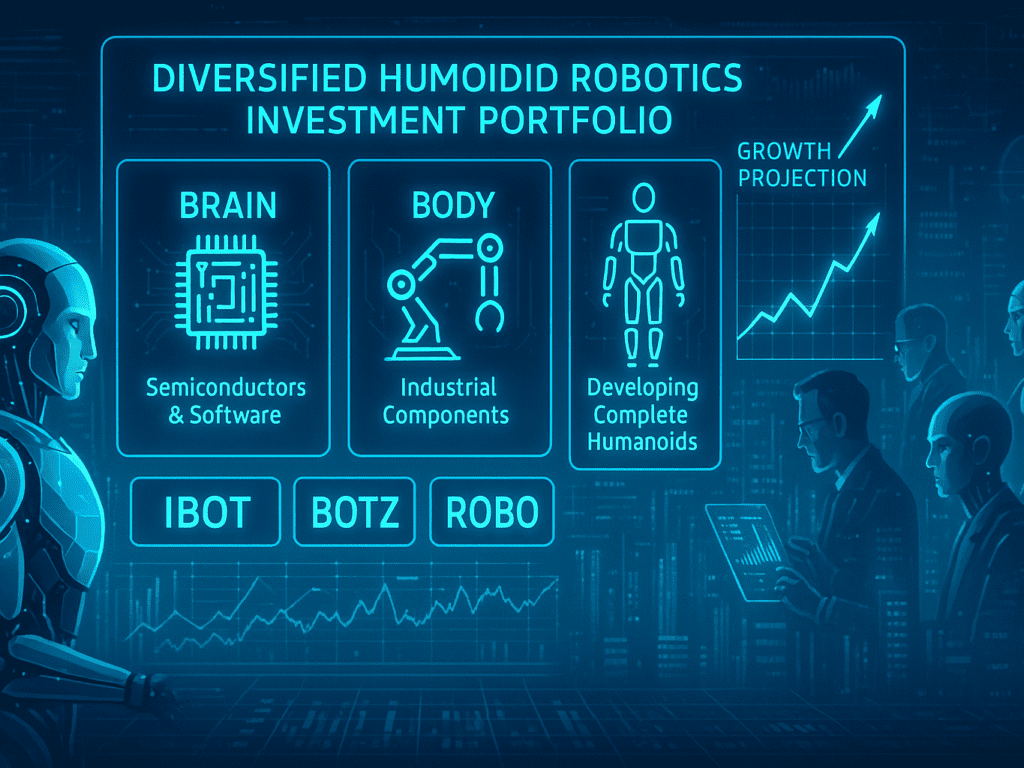
Building wealth through humanoid robot stocks needs a balanced approach between risk and growth potential. A diverse portfolio lets investors tap into this emerging sector while reducing the risks that come with new technologies.
1. Balancing established players with emerging innovators
Your humanoid robot’s stock portfolio should have both established companies and new, promising ones. Morgan Stanley’s “Humanoid 100” research divides investment opportunities into three groups:
- Brain: Semiconductors and Software
- Body: Industrial Components
- Integrators: Developing complete humanoids.
This structure helps investors access opportunities throughout the value chain.
The geographical spread creates challenges. 73% of companies use humanoids, and 77% of integrators are based in Asia. China accounts for 56% of companies and 45% of integrators. Western investors should carefully balance their regional exposure when picking humanoid robot stocks.
2. Robotics ETFs 2025 for broader exposure
Robotics ETFs 2025 offer a smart way to invest in humanoid robot stocks. Here are some options:
- VanEck Robotics ETF 2025 (IBOT): This fund tracks the BlueStar Robotics Index. It focuses on high-growth companies that enhance industrial automation.
- Global X Robotics & Artificial Intelligence ETF (BOTZ): Invests in companies that gain from robotics and AI across different sectors.
ROBO Global Robotics & Automation Index ETF (ROBO) began in 2013. It allows investors to access the expanding robotics and AI industries.
3. Risk management strategies for this emerging sector
Here’s how to reduce risks when investing in the humanoid robotics sector:
Market timing matters. Goldman Sachs predicts the humanoid robot market may reach $154 billion by 2035 if conditions are right. Short-term price swings should be expected.
The human-robot investment approach works well. Investors who use robots for rebalancing suggestions, while staying in control, achieve nearly the same returns as those with fully automated systems.
Look at component makers like Harmonic Drive Systems that hold near-monopoly positions. Combine these with pure-play humanoid robotics companies. This will balance steady revenue with growth potential.
Key Metrics to Evaluate When Investing in Humanoid Robotics
Successful investing in humanoid robot stocks needs a clear plan. It should focus on more than just flashy promises. Investors should look at key metrics that impact long-term value in this fast-changing sector.
1. R&D investment and patent portfolio
The intellectual property landscape offers key insights into the world of humanoid robotics. Sanctuary AI ranks fourth globally for patent holdings in general-purpose robotics and dexterous manipulation, signalling a major competitive edge. Tech+IP Advisory research uncovered over 3,000 assets tied to general-purpose robots and nearly 1,000 focused on dexterous manipulation technologies. Developing humanoid robots often requires R&D investments exceeding $1 billion, making patent strength a critical factor for long-term success in this space.
2. Commercial deployment timelines
Commercial deployment speed serves as a basic value indicator for the humanoid robot market. Figure AI plans to ship 100,000 humanoid robots in the next four years. Agility Robotics has a new 70,000-square-foot facility. It can make 10,000 robots each year. GXO tests humanoids from three different manufacturers in real-life warehouse environments. This shows that the shift from laboratory to commercial applications has started.
3. Strategic partnerships and market adoption indicators
Strategic collaborations validate the commercial viability of humanoid robot stocks.
Notable partnerships are:
- Apptronik is teaming up with Google DeepMind.
- Boston Dynamics is working with Hyundai Motor Group.
- Jabil is joining forces with Apptronik for manufacturing.
BMW’s use of humanoid robots in production is a key milestone for humanoid robotics.
4. Production scalability and unit economics
The economics behind humanoid robots keeps improving faster. Manufacturing costs dropped by about 40% in the last year. Current production costs range between $30,000 and $150,000 per unit. Apptronik’s partnership with Jabil tackles a significant challenge. The manufacturing expert offers “flexibility to scale production around the world”. This greatly boosts the commercial viability of humanoid robots.
Conclusion: Positioning Your Portfolio for the Humanoid Revolution
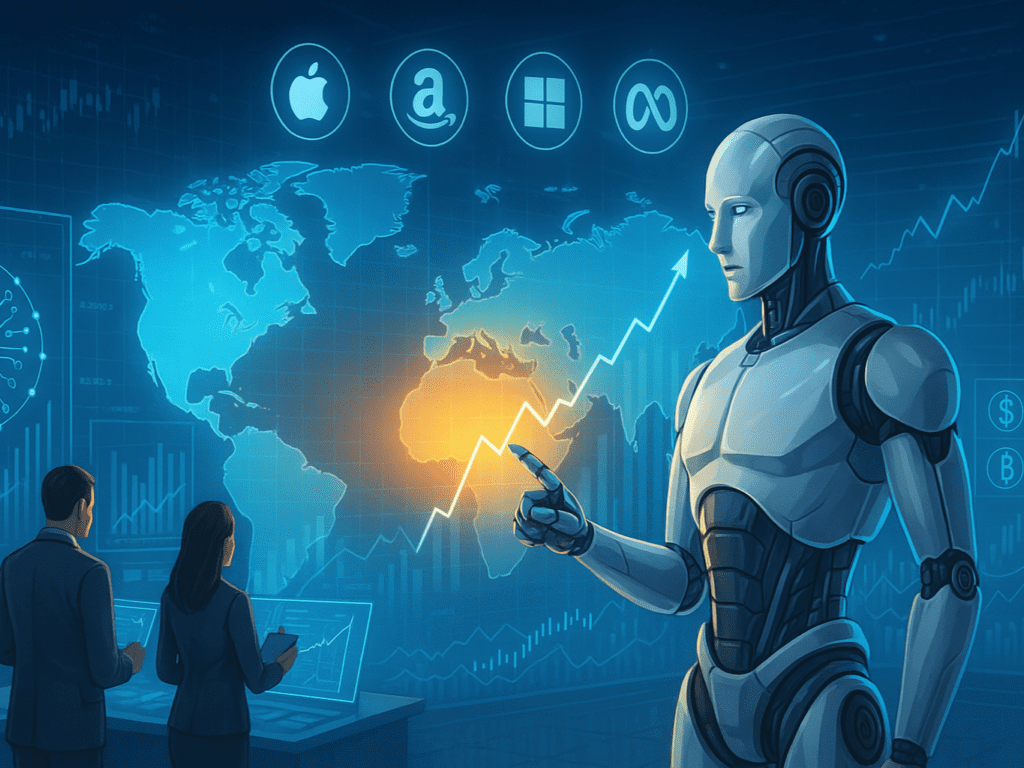
Humanoid robot stocks are set to grow fast, similar to Nvidia’s amazing success in AI computing. The sector has great potential. Goldman Sachs projects it will reach $38 billion. Meanwhile, Morgan Stanley estimates a huge $3 trillion market.
Investors can enter this market in a few ways: pure-play manufacturers, component suppliers, AI providers, and tech giants. Promising companies invest a lot in R&D. They also set clear commercial timelines and form strong partnerships with industry leaders.
Technology advances quickly while production costs drop steadily. This combination speeds up adoption in many industries. Companies with strong patent portfolios, flexible manufacturing, and successful market uses are great investment targets.
Smart investors understand that success in this new sector requires careful analysis of metrics and a mix of different investments. Investors who pick the right humanoid robot stocks could earn big returns. These technologies are changing industries all over the world.


